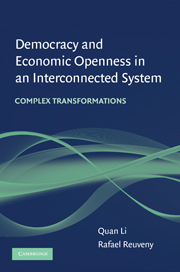1 - Introduction
Published online by Cambridge University Press: 05 June 2012
Summary
Two important and complex transformations have characterized the global political–economic system since the end of World War II in 1945. One transformation is the rise and spread of democracy over time and across countries. By the term democracy, we mean a national system of political governance based on free elections and broad political representation. We conceptualize this concept as a continuum of political regime types, ranging from full autocracy at one end to full democracy at the other end.
The second transformation is the expansion and deepening of globalization. In recent decades, globalization has been a popular term but is more complex to define than democracy. Scholars typically employ this term to describe recent global transformations toward growing cross-national interconnectedness. Although many scholars tend to focus on the interconnectedness features of particular interest to their own disciplines, some take a broader perspective. For example, Held et al. (2009) cast a wide net, covering essentially all the transformations that have increased international interconnectedness, including political-legal (e.g., growth of international treaties and institutions), military (e.g., disputes, growth of armies, and weapon proliferation), communication and informational (e.g., Internet, telephone, and media), economic flows (e.g., trade and investments), knowledge flows (technology transfers and education), taste convergence (e.g., consumption preferences), social contacts (e.g., migration and tourism), and environmental developments (e.g., pollution and changes in the biosphere), as well as the national and international income inequalities resulting from these processes.
- Type
- Chapter
- Information
- Democracy and Economic Openness in an Interconnected SystemComplex transformations, pp. 1 - 20Publisher: Cambridge University PressPrint publication year: 2009

